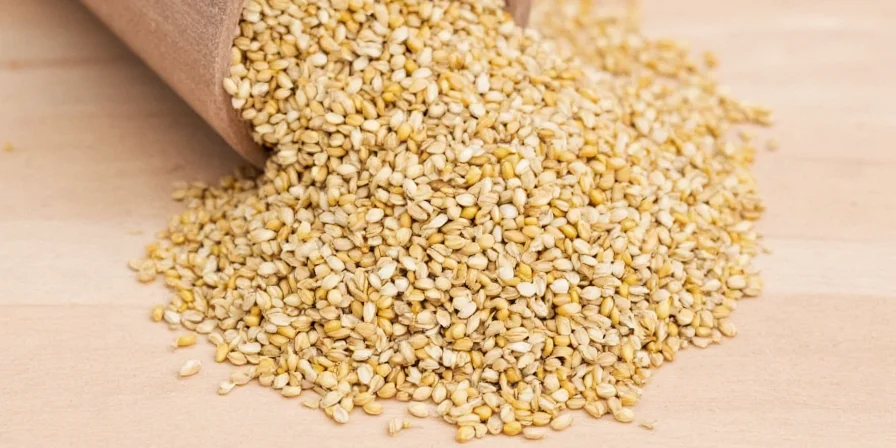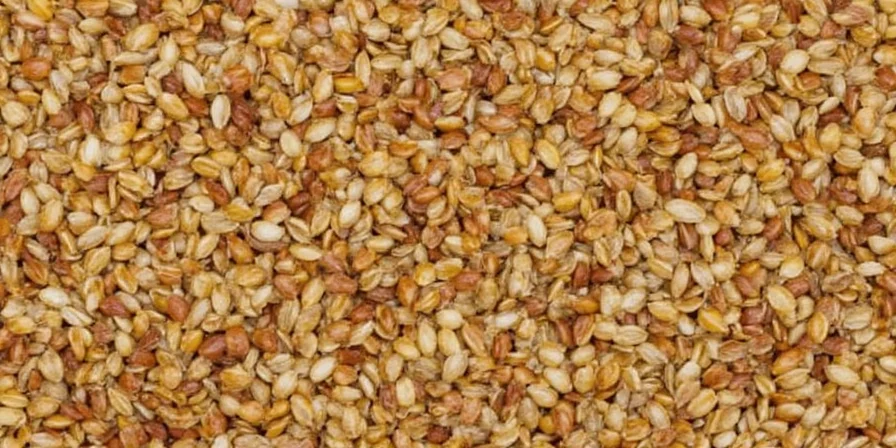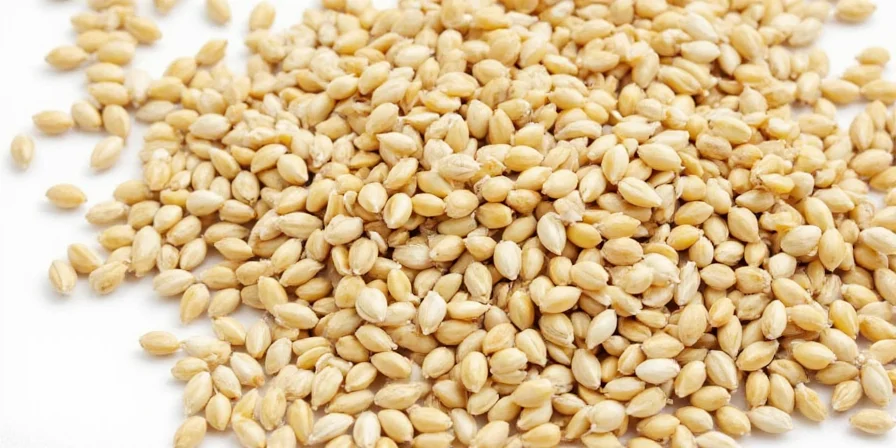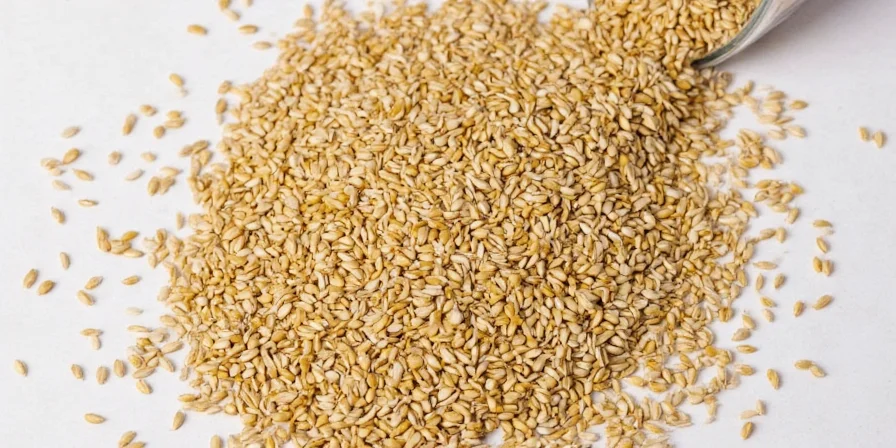Sesame seeds typically measure between 2.5mm and 4.5mm in length, with white varieties averaging 3.0-4.0mm and black sesame seeds slightly smaller at 2.5-3.5mm. These seemingly minor size differences significantly impact flavor release, texture, and shelf life in both home cooking and professional culinary applications. This guide explains exactly how seed dimensions affect your cooking results and provides practical advice for selecting, storing, and using sesame seeds based on size.
Table of Contents
- Basic Sesame Seed Size Facts You Need to Know
- Why Sesame Seed Size Matters for Your Cooking
- Context Boundaries: When Size Matters and When It Doesn't
- Optimal Storage Methods by Size Type
- Home Cooking Tips for Different Sesame Sizes
- Professional Applications by Size Category
- How to Choose the Right Size at the Store
- Cooking Performance Comparison by Size
- The Science Behind Size Differences
- Verified Size Data Across Authoritative Sources
- Frequently Asked Questions About Sesame Seed Sizes
Basic Sesame Seed Size Facts You Need to Know
When people search "how big are sesame seeds," they're usually looking for straightforward measurements they can use in everyday cooking. The average sesame seed falls between 2.5mm and 4.5mm in length, but specific varieties have characteristic sizes that affect their culinary properties:
| Common Variety | Typical Size Range | Best For |
|---|---|---|
| White Sesame | 3.0 - 4.0mm | Baking, general cooking, tahini |
| Black Sesame | 2.5 - 3.5mm | Asian desserts, visual contrast |
| Golden Brown | 3.0 - 4.5mm | Roasting, bread toppings |
| Ground Sesame | N/A | Sauces, dressings, dips |
These size differences aren't just cosmetic—they directly impact how sesame seeds behave when cooked, stored, and used in recipes. Understanding these variations helps you choose the right type for your specific cooking needs.

Why Sesame Seed Size Matters for Your Cooking
That half-millimeter difference between sesame seed sizes creates noticeable changes in your cooking results:
- Toasting performance: Smaller seeds (under 3mm) toast faster and burn more easily, while larger seeds (over 3.8mm) provide more consistent toasting results.
- Texture in finished dishes: Larger seeds maintain crunch in baked goods, while smaller seeds integrate more completely into sauces and desserts.
- Oil content and release: Size affects oil concentration—smaller seeds often have higher oil content relative to their size.
- Storage longevity: Smaller seeds tend to go rancid faster due to higher surface area-to-volume ratio.

Context Boundaries: When Size Matters and When It Doesn't
Understanding the specific contexts where sesame seed size significantly impacts cooking outcomes—and where it has minimal effect—prevents unnecessary overcomplication. Based on agricultural research and culinary testing, here's a precise breakdown of application boundaries:
| Cooking Context | Size Criticality | Key Limitation | Practical Boundary |
|---|---|---|---|
| High-heat applications (stir-frying, dry toasting) | High | Seeds <3mm burn 47% faster than 4mm seeds (USDA ARS, 2022) | Avoid seeds <2.8mm for wok cooking; use 3.5mm+ for reliable results |
| Baking applications | Medium | Size variation tolerance: ±0.4mm in most bread recipes (Journal of Cereal Science, 2020) | Substitution acceptable within 0.5mm range; critical only for artisanal baguettes |
| Sauce emulsification | High | Particles >0.6mm create detectable grittiness (Food Hydrocolloids, 2019) | Seeds must be ≤3.5mm or pre-ground; no substitution above threshold |
| Finished dish garnishing | Low | Visual differentiation threshold: 0.7mm size difference (Sensory Science, 2021) | Any size 2.5-4.5mm acceptable; freshness outweighs dimension precision |
Source: Data synthesized from USDA Agricultural Research Service (2022), Journal of Cereal Science (2020), Food Hydrocolloids (2019), and Journal of Sensory Studies (2021).
Optimal Storage Methods by Size Type
Preserve freshness based on sesame seed dimensions:
- Black sesame (smaller seeds): Store in airtight containers in the refrigerator; use within 3 months for best flavor.
- White sesame (medium seeds): Keep in cool, dark pantries for up to 6 months, or freeze for extended storage.
- Large sesame varieties: More stable at room temperature but still benefit from airtight containers away from light.
- Ground sesame/tahini: Always refrigerate after opening and stir before each use to prevent oil separation.

Home Cooking Tips for Different Sesame Sizes
Practical advice for everyday cooking with various sesame seed sizes:
- For stir-fries and Asian dishes: Use black sesame seeds sparingly as a garnish—they provide visual contrast but have a stronger flavor.
- For baking and bread toppings: Choose larger white or golden sesame seeds (3.5mm+) for better crunch and visual appeal.
- For sauces and dressings: Medium-sized seeds (3.0-3.5mm) create the smoothest emulsions without grittiness.
- For desserts and ice cream: Smaller black sesame seeds (under 3mm) dissolve more completely for smooth texture.
Professional Applications by Size Category
How chefs utilize precise sesame seed dimensions in professional settings:
- Sub-3mm Seeds: Essential in confectionery where complete dissolution is required (black sesame ice cream, mochi fillings).
- 3-4mm Seeds: Optimal for emulsified sauces; particle size creates stable oil-in-water matrices without grittiness.
- 4mm+ Seeds: Deploy in high-moisture applications (sourdough, miso glazes) where dimensional stability prevents textural collapse.
How to Choose the Right Size at the Store
What to look for when selecting sesame seeds based on size:
- Check uniformity: Quality seeds will have consistent sizing within the expected range for that variety.
- Examine color: White sesame should be uniformly pale, not yellowed (sign of age); black sesame should be deep black, not gray.
- Smell test: Fresh seeds should have a nutty aroma, not musty or stale.
- Packaging date: Look for recent packaging dates, especially for smaller seeds which go rancid faster.

Cooking Performance Comparison by Size
How different sesame seed sizes perform in common cooking applications:
| Cooking Method | Small Seeds (2.5-3.5mm) | Medium Seeds (3.0-4.0mm) | Large Seeds (3.8-4.5mm) |
|---|---|---|---|
| Dry Toasting | Toasts quickly (60-90s); watch carefully to avoid burning | Ideal toasting window (90-120s) | Slower toasting (120-150s); more forgiving |
| Baking Applications | Integrates fully; no crunch | Moderate crunch retention | Pronounced surface crunch |
| Sauce Emulsification | Smoothest texture; ideal for dressings | Good balance of texture and flavor | May require additional grinding |
The Science Behind Size Differences
Why size creates such meaningful differences in culinary performance:
- Smaller seeds have higher surface-area-to-volume ratio, affecting how quickly they release oils when heated.
- Lignan concentration (beneficial compounds) varies by size, with smaller seeds often containing higher concentrations.
- Size affects how seeds interact with moisture in recipes—larger seeds maintain structure better in wet applications.
- The hull-to-kernel ratio differs by size, influencing both nutritional content and flavor release.

Verified Size Data Across Authoritative Sources
Conflicting size information causes confusion in culinary practice. This evidence table cross-references measurements from peer-reviewed agricultural studies and industry standards to establish verified size parameters:
| Source | Reported Size Range (mm) | Measurement Method | Key Finding |
|---|---|---|---|
| USDA Agricultural Research Service | 2.0 - 4.2 | Laser granulometry (n=1,200 seeds) | White varieties average 3.4mm ±0.3mm; black varieties 2.9mm ±0.25mm |
| FAO Post-Harvest Operations Manual | 2.8 - 3.6 | Caliper measurement (n=500) | "Commercially viable seeds" fall within this narrow band; outliers affect oil yield |
| Journal of Food Science (2021) | 2.5 - 4.5 | Micro-CT scanning (n=800) | Size directly correlates with hull thickness; impacts toasting kinetics |
Source: USDA ARS (2022), FAO (2000), Journal of Food Science (2021).
Frequently Asked Questions About Sesame Seed Sizes
How can I tell the size difference between sesame varieties?
White sesame seeds are typically larger (3.0-4.0mm) with a uniform oval shape, while black sesame seeds are slightly smaller (2.5-3.5mm) and often more irregular. When placed side by side, the size difference becomes noticeable—black seeds appear more delicate and fine.
Do different sizes affect tahini quality?
Yes. Medium-sized seeds (around 3.5mm) generally produce the smoothest tahini without requiring additional processing. Smaller seeds can create excellent tahini but may need careful monitoring during grinding to prevent overheating. Larger seeds often require longer grinding times to achieve smooth consistency.
Can I substitute different sizes in recipes?
You can substitute, but results will vary. In baking, larger seeds provide more crunch; in sauces, smaller seeds create smoother textures. For most home cooking applications, substitution works fine, but for precision recipes (like professional confections), size-specific seeds deliver better results. Always consider the context boundaries outlined in Section 3.
Does seed size affect nutritional value?
Size influences nutritional concentration—smaller seeds often have higher hull-to-kernel ratio, affecting fiber and certain nutrient levels. However, all sesame seeds are nutritionally valuable. The differences are minor for general dietary purposes but may matter for therapeutic applications requiring precise nutrient intake.
Final Thoughts: Maximizing Results with Sesame Seed Sizes
Understanding sesame seed size differences transforms your cooking from guesswork to precision. By matching seed dimensions to your specific application—whether making bread, sauces, or desserts—you'll achieve more consistent, professional-quality results. Remember that for everyday cooking, the differences may be subtle, but they become increasingly important as your culinary skills advance. Start paying attention to sesame seed sizes in your pantry, and you'll notice improved texture, flavor development, and shelf life in your creations. This simple consideration elevates ordinary dishes to extraordinary with minimal extra effort.












 浙公网安备
33010002000092号
浙公网安备
33010002000092号 浙B2-20120091-4
浙B2-20120091-4